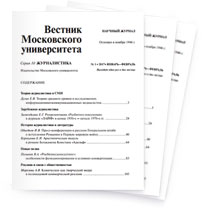The Narrative of the Skripals Case in the "Vesti Nedeli" Television Program: an Analysis of the Story Plot
Download paperPhD in Philology, Associate Professor at the Chair of Theory and History of Journalism, Faculty of Philology, People's Friendship University of Russia, Moscow, Russia
e-mail: algawy_lo@rudn.ruDoctor of Philology, Professor at the Chair of Mass Communications, Faculty of Philology, Peoples’ Friendship University of Russia, Moscow, Russia
e-mail: volkova-ii@rudn.ruPhD in Philology, Senior Lecturer at the Chair of Theory and History of Journalism, Faculty of Philology, Peoples’ Friendship University of Russia, Moscow, Russia
e-mail: kadyrova_shn@rudn.ruPhD in Philology, Senior Lecturer at the Chair of Theory and History of Journalism, Faculty of Philology, Peoples’ Friendship University of Russia, Moscow, Russia
e-mail: rastorgueva_ne@rudn.ruSection: Television and Radio
This paper presents the results of a quantitative and qualitative analysis of data that contended in the scripts of twenty-seven episodes of the informational TV show “Vesti Nedeli” (Russia 1, 2018) The attribution is based on C. Booker's universal plots, thanks to which it was possible to reveal the narrative peculiarities of Skripal Case represented by D. Kiselev and the correspondents of his show. The reasearch made it possible to identify that a basic plot that was represented in the news narrative of Skripal Case is a tragedy with the prescribed set of the characters and the consistent unravelling of the story in actes. It has been found that at the centre of journalists' narration is no Skripals, but the United Kingdom (subject) in the context of its relationship to Russia (object). The authors allocated subject-object roles the story characters, while Teresa May marked as the tragedy's lead character.
DOI: 10.30547/vestnik.journ.3.2019.6283References:
Bennett W. L. (2003) News Content: Four Information Biases That Matter. In W. L. Bennett (ed.) News: The Politics of Illusion. Chicago-London: The University of Chicago Press. Pp. 28–58.
Berdayes L., Berdayes V. (1998) The Information Highway in Contemporary Magazine Narrative. Journal of Communication 48 (2): 109–124.
Bird S. E., Dardenne R. W. (1988) Myth, Chronicle, and Story: Exploring the Narrative Qualities of News. In J. W. Carey (ed.) Media, myths, and narratives. Beverly Hills: CA Sage. Pp. 67–87.
Booker C. (2004) The Seven Basic Plots: Why We Tell Stories. The Seven Basic Plots: Why We Tell Stories. London: Continuum Books.
Borges J. L. (1972) El Oro De Los Tigres. Buenos Aires: Ediciones Neperus. (In Spanish)
Branigan E. (1992) Narrative Comprehension and the Fiction Film. London: Routledge.
Brooks P. (1985) Reading for the Plot: Design and Intention in Narrative. New York: Random House.
Davis L. J. (1987) Resisting Novels: Ideology and Fiction. London: Methuen.
Hall S. (1975) Introduction. In A. C. H. Smith, E. Immirzi, T. Blackwell (eds.) Paper Voices: the Popular Press and Social Change. New Jersey: Rowman and Littlefield. Pp. 11–24.
Kermode F. (1966) The Sense of an Ending: Studies in the Theory of Fiction. Oxford: Oxford University Press.
Labov W., Waletzky J. (1967) Narrative Analysis. Essays on the Verbal and Visual Arts. Seattle: U Washington Press. Pp. 12–44.
Lule J. (2001) Daily News, Eternal Stories: the Mythological Role of Journalism. New York: Guilford.
Paley J. (2009) Narrative Machinery. In Y. Gunaratnam, D. Oliviere (eds.) Narrative and Stories in Health Care: Illness, Dying, and Bereavement. Oxford: Oxford University Press.
Polti G. (1921) The Thirty-Six Dramatic Situations. Franklin, Ohio: James Knapp Reeve.
Ponomaryov N. F. (2014) Storitelling i ritorika v publichnom diskurse. Filologiya v XXI veke: metody, problemy, idei: materialy II Vseros. nauch. konf., 2014 [Storytelling and Rhetoric in Public Discourse. Philology in the 21st Century: Methods, Problems, Ideas: Proceedings of the 2nd All-Russian Scientific Conference, 2014]. Perm’: Permsk. gos. nac. issled. un-ta Publ. Pp. 151–157. (In Russian)
Propp V. J. (1928) Morfologiya skazki [Morphology of the Folktale]. Leningrad: Academia. (In Russian)
Ryan M. L. (2013) Defining Media from the Perspective of Narratology. Handelshøjskolen i Århus, Institut for Sprog og Erhvervskommunikation, VÆRK working paper series. Available at: http://pure.au.dk/portal/files/7562/M-L_Ry-ans_paper.pdf (accessed: 14.04.2019).
Tobias R. (1993) Master Plots: and How to Build Them. F+W Media.
Tyupa V. I. (2018) Zhanrovaya priroda narrativnyh strategij [Genre Nature of Narrative Strategies]. Filologicheskij klass 2 (52): 19–24. (In Russian).






